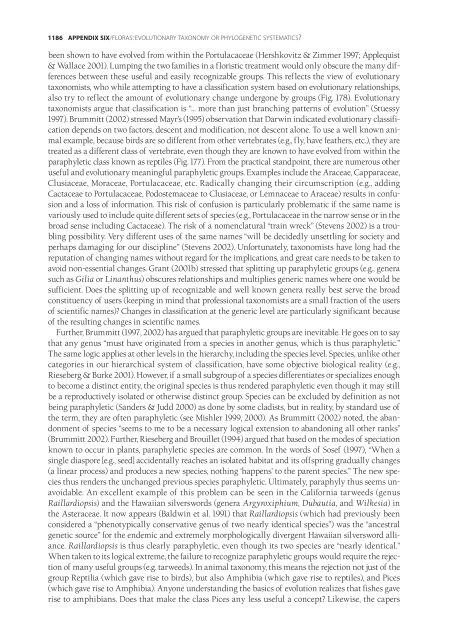Appendices & Glossary - Botanical Research Institute of Texas
Appendices & Glossary - Botanical Research Institute of Texas
Appendices & Glossary - Botanical Research Institute of Texas
Create successful ePaper yourself
Turn your PDF publications into a flip-book with our unique Google optimized e-Paper software.
1186 APPENDIX SIX/FLORAS: EVOLUTIONARY TAXONOMY OR PHYLOGENETIC SYSTEMATICS?<br />
been shown to have evolved from within the Portulacaceae (Hershkovitz & Zimmer 1997; Applequist<br />
& Wallace 2001). Lumping the two families in a floristic treatment would only obscure the many differences<br />
between these useful and easily recognizable groups. This reflects the view <strong>of</strong> evolutionary<br />
taxonomists, who while attempting to have a classification system based on evolutionary relationships,<br />
also try to reflect the amount <strong>of</strong> evolutionary change undergone by groups (Fig. 178). Evolutionary<br />
taxonomists argue that classification is “… more than just branching patterns <strong>of</strong> evolution” (Stuessy<br />
1997). Brummitt (2002) stressed Mayr’s (1995) observation that Darwin indicated evolutionary classification<br />
depends on two factors, descent and modification, not descent alone. To use a well known animal<br />
example, because birds are so different from other vertebrates (e.g., fly, have feathers, etc.), they are<br />
treated as a different class <strong>of</strong> vertebrate, even though they are known to have evolved from within the<br />
paraphyletic class known as reptiles (Fig. 177). From the practical standpoint, there are numerous other<br />
useful and evolutionary meaningful paraphyletic groups. Examples include the Araceae, Capparaceae,<br />
Clusiaceae, Moraceae, Portulacaceae, etc. Radically changing their circumscription (e.g., adding<br />
Cactaceae to Portulacaceae, Podostemaceae to Clusiaceae, or Lemnaceae to Araceae) results in confusion<br />
and a loss <strong>of</strong> information. This risk <strong>of</strong> confusion is particularly problematic if the same name is<br />
variously used to include quite different sets <strong>of</strong> species (e.g., Portulacaceae in the narrow sense or in the<br />
broad sense including Cactaceae). The risk <strong>of</strong> a nomenclatural “train wreck” (Stevens 2002) is a troubling<br />
possibility. Very different uses <strong>of</strong> the same names “will be decidedly unsettling for society and<br />
perhaps damaging for our discipline” (Stevens 2002). Unfortunately, taxonomists have long had the<br />
reputation <strong>of</strong> changing names without regard for the implications, and great care needs to be taken to<br />
avoid non-essential changes. Grant (2001b) stressed that splitting up paraphyletic groups (e.g., genera<br />
such as Gilia or Linanthus) obscures relationships and multiplies generic names where one would be<br />
sufficient. Does the splitting up <strong>of</strong> recognizable and well known genera really best serve the broad<br />
constituency <strong>of</strong> users (keeping in mind that pr<strong>of</strong>essional taxonomists are a small fraction <strong>of</strong> the users<br />
<strong>of</strong> scientific names)? Changes in classification at the generic level are particularly significant because<br />
<strong>of</strong> the resulting changes in scientific names.<br />
Further, Brummitt (1997, 2002) has argued that paraphyletic groups are inevitable. He goes on to say<br />
that any genus “must have originated from a species in another genus, which is thus paraphyletic.”<br />
The same logic applies at other levels in the hierarchy, including the species level. Species, unlike other<br />
categories in our hierarchical system <strong>of</strong> classification, have some objective biological reality (e.g.,<br />
Rieseberg & Burke 2001). However, if a small subgroup <strong>of</strong> a species differentiates or specializes enough<br />
to become a distinct entity, the original species is thus rendered paraphyletic even though it may still<br />
be a reproductively isolated or otherwise distinct group. Species can be excluded by definition as not<br />
being paraphyletic (Sanders & Judd 2000) as done by some cladists, but in reality, by standard use <strong>of</strong><br />
the term, they are <strong>of</strong>ten paraphyletic (see Mishler 1999, 2000). As Brummitt (2002) noted, the abandonment<br />
<strong>of</strong> species “seems to me to be a necessary logical extension to abandoning all other ranks”<br />
(Brummitt 2002). Further, Rieseberg and Brouillet (1994) argued that based on the modes <strong>of</strong> speciation<br />
known to occur in plants, paraphyletic species are common. In the words <strong>of</strong> Sosef (1997), “When a<br />
single diaspore [e.g., seed] accidentally reaches an isolated habitat and its <strong>of</strong>fspring gradually changes<br />
(a linear process) and produces a new species, nothing ‘happens’ to the parent species.” The new species<br />
thus renders the unchanged previous species paraphyletic. Ultimately, paraphyly thus seems unavoidable.<br />
An excellent example <strong>of</strong> this problem can be seen in the California tarweeds (genus<br />
Raillardiopsis) and the Hawaiian silverswords (genera Argyroxiphium, Dubautia, and Wilkesia) in<br />
the Asteraceae. It now appears (Baldwin et al. 1991) that Raillardiopsis (which had previously been<br />
considered a “phenotypically conservative genus <strong>of</strong> two nearly identical species”) was the “ancestral<br />
genetic source” for the endemic and extremely morphologically divergent Hawaiian silversword alliance.<br />
Raillardiopsis is thus clearly paraphyletic, even though its two species are “nearly identical.”<br />
When taken to its logical extreme, the failure to recognize paraphyletic groups would require the rejection<br />
<strong>of</strong> many useful groups (e.g. tarweeds). In animal taxonomy, this means the rejection not just <strong>of</strong> the<br />
group Reptilia (which gave rise to birds), but also Amphibia (which gave rise to reptiles), and Pices<br />
(which gave rise to Amphibia). Anyone understanding the basics <strong>of</strong> evolution realizes that fishes gave<br />
rise to amphibians. Does that make the class Pices any less useful a concept? Likewise, the capers
















